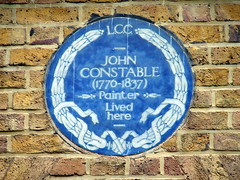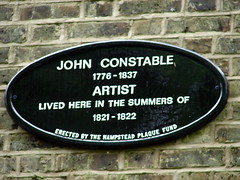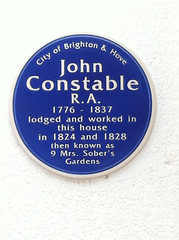John Constable RA


John Constable RA
(1776-1837)
painter, artist, and Royal Academician
Commemorated on 4 plaques
John Constable (1776-1837) painter lived here
40 Well Walk, NW3 1BX, London, United Kingdom where they lived (1827)
John Constable 1776-1837 Artist lived here in the summers of 1821-1822
2 Lower Terrace, Hampstead, NW3 6RG, London, United Kingdom where they lived (1821-1822)
John Constable RA 1776-1837 lodged and worked in this house in 1824 and 1828 then known as 9 Mrs Sober's Gardens
11 Sillwood Road, Brighton, United Kingdom where they lived (1824) and lodged (1828)
John Constable lived in Hampstead between the years 1819 - 1837. One of the earliest and most celebrated of his Hampstead landscapes now in the Tate Gallery is 'A View to the North-West' which shows The Heath, Branch Hill Pond and Harrow in the far distance. It takes its title from a house called the 'Salt Box' which stood on this site.
Mansion Gardens, NW3 7NG, London, United Kingdom where they lived (1818-1836)




